I would suggest passing tesseract every row of text as separate image.
For some reason it seams to solve the decimal point issue...
- Convert image from grayscale to black and white using
cv2.threshold.
- Use
cv2.dilate morphological operation with very long horizontal kernel (merge blocks across horizontal direction).
- Use find contours - each merged row is going to be in a separate contour.
- Find bounding boxes of the contours.
- Sort the bounding boxes according to the y coordinate.
- Iterate bounding boxes, and pass slices to
pytesseract.
Here is the code:
import numpy as np
import cv2
import pytesseract
pytesseract.pytesseract.tesseract_cmd = r'C:\Program Files\Tesseract-OCR\tesseract.exe' # I am using Windows
path_to_image = 'image.png'
img = cv2.imread(path_to_image, cv2.IMREAD_GRAYSCALE) # Read input image as Grayscale
# Convert to binary using automatic threshold (use cv2.THRESH_OTSU)
ret, thresh = cv2.threshold(img, 0, 255, cv2.THRESH_BINARY_INV + cv2.THRESH_OTSU)
# Dilate thresh for uniting text areas into blocks of rows.
dilated_thresh = cv2.dilate(thresh, np.ones((3,100)))
# Find contours on dilated_thresh
cnts = cv2.findContours(dilated_thresh, cv2.RETR_EXTERNAL, cv2.CHAIN_APPROX_NONE)[-2] # Use index [-2] to be compatible to OpenCV 3 and 4
# Build a list of bounding boxes
bounding_boxes = [cv2.boundingRect(c) for c in cnts]
# Sort bounding boxes from "top to bottom"
bounding_boxes = sorted(bounding_boxes, key=lambda b: b[1])
# Iterate bounding boxes
for b in bounding_boxes:
x, y, w, h = b
if (h > 10) and (w > 10):
# Crop a slice, and inverse black and white (tesseract prefers black text).
slice = 255 - thresh[max(y-10, 0):min(y+h+10, thresh.shape[0]), max(x-10, 0):min(x+w+10, thresh.shape[1])]
text = pytesseract.image_to_string(slice, config="-c tessedit"
"_char_whitelist=abcdefghijklmnopqrstuvwxyzABCDEFGHIJKLMNOPQRSTUVWXYZ1234567890-:."
" --psm 3"
" ")
print(text)
I know it's not the most general solution, but it manages to solve the sample you have posted.
Please treat the answer as a conceptual solution - finding a robust solution might be very challenging.
Results:
Thresholder image after dilate:

First slice:

Second slice:

Third slice:

Output text:
7.3-8.2
Primo:50





